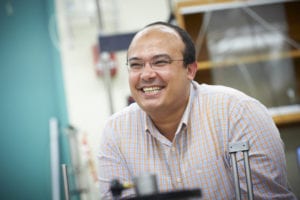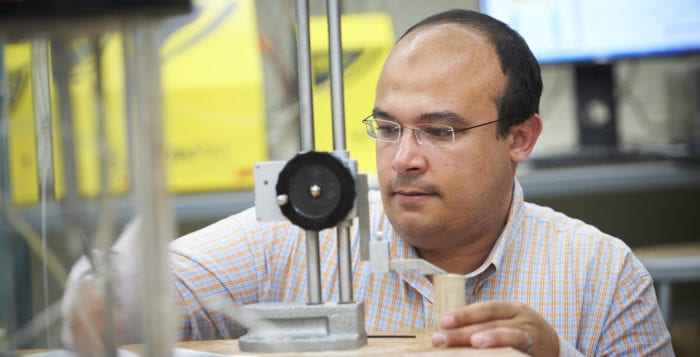By Daniel Dunaief
When the temperature drops dramatically, people put on extra layers of clothing or rush inside. At the other extreme, when the mercury climbs toward the top of thermometers, they turn on sprinklers, head to the beach or find cold drinks.
That, however, is not the case for the clay that is often underneath buildings, cliffs or the sides of hills on which people build picturesque homes. Clay shrinks after heating-cooking cycles in summer and also after freezing-thawing cycles in winter. “We want to understand why and how this behavior happens,” said Sherif Abdelaziz, an assistant professor in the Department of Civil Engineering at Stony Brook University.

Abdalaziz recently received a prestigious Young Investigator Program award from the U.S. Army Research Office, which will provide $356,000 in funding over three years to study these properties. While the work will explore the basic science behind these clay materials, his findings could have a broad range of applications, from providing potential early-warning systems for future landslides or mudslides to monitoring coastal bluffs to keeping track of the soil around high-temperature nuclear waste buried in the ground.
Miriam Rafailovich, a distinguished professor in the Department of Materials Science at SBU who is beginning a collaboration with Abdelaziz, suggested that Abdelaziz’s work is relevant in multiple areas. “It applies to shoring infrastructure,” she wrote in an email. “The collapse of roadbeds under heavy traffic is a very common problem.”
Additionally, the clay around nuclear waste is subjected to very high temperatures during the period the waste is active. These temperatures recover to initial temperature with time, which will mainly subject the clay to a heating-cooling cycle that is part of this study, Abdelaziz explained. He is pleased to have the opportunity to explore these kinds of questions.
The Young Investigator Program award is “one of the most prestigious honors bestowed by the Army on outstanding scientists beginning their independent careers,” explained Julia Barzyk, a program manager in earth materials and processes at the U.S. Army Research Office, in an email. Abdelaziz’s research “is expected to contribute to improved approaches to mobility and siting and maintenance of infrastructure, especially in cold regions such as the Arctic.”
The field in which Abdelaziz works is called the thermomechanical behavior of soil. The challenge in this area, he said, is that the scientists are often divided into two groups. Some researchers focus on the heating effect on soil, while others explore cooling. In the real world, however, soil is exposed to both types of conditions, which could affect its ability to support structures above or around it.
In general, Abdelaziz has focused on clay. So far, scientists have looked at a piece or chunk of clay to see how it behaves. They haven’t done enough exploration at the microscale level, he said. “Our scientific approach crosses between the scales,” he said. In conducting experiments at SBU and at Brookhaven National Laboratory, he starts at the microscale and looks at the larger macroscale.
At the National Synchrotron Light Source II at BNL, Abdelaziz and his partners at BNL, including Eric Dooryhee, the beamline director for the X-ray Powder Diffraction beamline, change the temperature of the clay and look at the microstructure.
The challenge in the experiments they conducted last year was that they could change the temperature, but they couldn’t mimic the pressure conditions in the ground. Recently, they conducted the first experiments on a sample environment that involved a change in temperature and pressure and they got “good results so far,” Abdelaziz said in an email. He is looking for more beam time in the summer to finish the development of the sample environment. He is also seeking funding for a project to develop an early-warning system for coastal bluff stability.
“We are pretty good at predicting the weather,” Abdelaziz said. “What we don’t know is how this storm will impact our slopes.” The goal of the work he’s exploring now is to use what he learns from these experiments to predict potential changes in the soil. The purpose of this work is to better engineer mitigation techniques to avoid evacuations.
Abdelaziz’s work has focused on one clay type. He has, however, built a numerical model using experimental data. Once that model is validated, it will be able to predict the behavior of other clay, and he can include the heterogeneity of earth surface material in his numerical studies.
Rafailovich appreciates Abdelaziz’s dedication to his research. “He is very passionate about his work,” she wrote in an email. “He really hopes that he can change the world, one small road at a time.”
A native of Cairo, Egypt, Abdelaziz lives in Smithtown with his wife Heba Elnoby and their children Mohamed, 10, and Malak, 7. The father of two suggested that he “owes every single piece of success” in his career to the support he received from his wife.
The idea to study coastal bluff stability came to Abdelaziz when he was grilling on the beach a few years ago. He saw a sign that indicated that a bluff was unstable and that there was excessive movement. He related that to what he was studying. Abdelaziz is pleased with the funding and with the opportunity to contribute basic knowledge about clay to civil and military efforts. The financial support from the Army suggests that his “work is meaningful to the nation in general,” he said.





